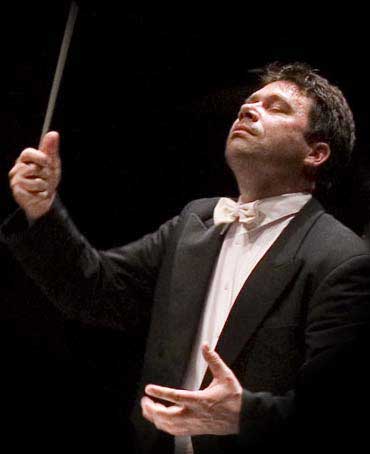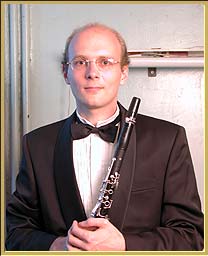- Русский
- English
MSO Master Series: March 16
Arthur Arnold - Conductor
Evgeni Petrov - Clarinet
Mozart - Overture "Cosi fan tutte"
Mozart - Clarinet Concerto
Beethoven - Symphony No. 5
 Arthur Arnold is the Chief Conductor of the Moscow Symphony Orchestra and Music Director and Conductor of the Pacific Region International Summer Music Academy. He had a successful debut with the Moscow Symphony Orchestra and soloists of the Bolshoi Theater in the Concertgebouw in Amsterdam in 2001. Soon after this achievement he was appointed the principal guest conductor of this Russian orchestra. He and the orchestra have been frequently invited to return to The Netherlands for new performances. Meanwhile Arnold is guest conductor at many well known European, Asian and North American Orchestras. In The Netherlands he conducted the Radio Symphony Orchestra, the North Netherlands Orchestra, Arnhem Philharmonic, Holland Symfonia, Rotterdam Philharmonic Orchestra and the Nieuw Ensemble. Arnold appears in the documentary ‘A Thousand Voices, A Single Passion', about the International Choral Festival ‘Kathaumixw’ for which he is a jury member and orchestra conductor since 2000.
Arthur Arnold is the Chief Conductor of the Moscow Symphony Orchestra and Music Director and Conductor of the Pacific Region International Summer Music Academy. He had a successful debut with the Moscow Symphony Orchestra and soloists of the Bolshoi Theater in the Concertgebouw in Amsterdam in 2001. Soon after this achievement he was appointed the principal guest conductor of this Russian orchestra. He and the orchestra have been frequently invited to return to The Netherlands for new performances. Meanwhile Arnold is guest conductor at many well known European, Asian and North American Orchestras. In The Netherlands he conducted the Radio Symphony Orchestra, the North Netherlands Orchestra, Arnhem Philharmonic, Holland Symfonia, Rotterdam Philharmonic Orchestra and the Nieuw Ensemble. Arnold appears in the documentary ‘A Thousand Voices, A Single Passion', about the International Choral Festival ‘Kathaumixw’ for which he is a jury member and orchestra conductor since 2000.

Evgeny Petrov was born in Moscow in 1972, and studied clarinet at the Moscow Conservatory with Professor Vladimir Sokolov, with whom he pursued post-graduate study as well. His concert life began at age 14, and has since taken him to the finest halls in Russia (The Big Hall, Tchaikovsky Hall, the Palace of Composers, etc.), as well as on tour through much of Europe, the US, Mexico, and Japan. Among his many awards include First Prize at the International "Concertino-Prague" Competition (1989), Second Prize at the International Competition of Clarinetists (Geneva, 1990), and Recipient of the International "New Names" Charity Program Award (Russia, 1995). Mr. Petrov performs both as a soloist and with various chamber ensembles, including with the Borodin and Glazonov Quartets. He has appeared as a soloist with various orchestras and is a regular soloist with the Moscow State Philharmonic. He works with several top Russian pianists, including Valery Pyastesky, which whom he appears here at the Classical Archives. His repertory is quite vast, ranging from Classical to Contemporary works, and his music has been recorded by several labels, including Melodia, Dowani, and Etcetera. He is currently a professor of clarinet at the Moscow Conservatory, with several students who themselves have become prizewinners.
Wolfgang Amadeus Mozart (1756-1791) - Overture to Cosi fan tutte, K. 588
Cosi fan tutte (1790) is the third in the great trilogy of operas composed by Mozart with Lorenzo da Ponte as his librettist, the others being The Marriage of Figaro (1786) and Don Giovanni (1787). All three are comedies with Cosi being the most lighthearted and ebullient in its charm. The title, really untranslatable, is usually read as “Women are like that” or “So do they all,” and the overture is a short and delightful introduction to the story which deals with the vicissitudes of the male/female relationship. After a brief introduction, there is heard the theme which is sung later to the words of the title. The presto section gets the business of the overture under way and exudes good humour and exuberance. Towards the end, there is a repetition of the “cosi fan tutte” theme and the overture is brought to a formal close.
Wolfgang Amadeus Mozart - Clarinet Concerto in A Major, K. 622
Mozart spent the final decade of his life in Vienna. His first years there were the most successful period of his career. Audiences adored his music and his piano playing, while a steady stream of students and commissions for fresh pieces came his way.
But Viennese listeners proved fickle. The adult Mozart, no longer the fashionable child prodigy who had dazzled them in decades gone by, became just another musician in their eyes. Throughout his final years, he continued to earn money, but his complete inability to manage his finances swallowed it up. Also, mounting despair and increasingly poor health sapped his energies. His creative powers burned undimmed, however, and one masterpiece after another flowed from his pen.
The Clarinet Concerto, one of his final creations, displays his unsurpassed skill at creating balanced, mutually enriching dialogue between solo instruments and the orchestra. As had so often been the case, its inspiration came from a personal acquaintance. Mozart and clarinettist Anton Stadler first met in Salzburg, but it was only in Vienna that their personal and professional relationship came to full flower.
For Stadler, by then a member of the Austrian capital’s Imperial Court Orchestra, Mozart first composed a magnificent quintet for clarinet and strings, then this concerto. He probably began writing it immediately following the premiere of his comic opera The Magic Flute, on September 30, 1791. He crafted it to suit Stadler’s preferred instrument, the basset clarinet, whose range extended lower than the modern orchestral clarinet. The concerto is known today in an anonymous transcription, dating from about 1800, adapted to suit the type of clarinet that has been commonly used since then.
The mellow, expressive voice of the clarinet proved to be the perfect medium to express what he must have been feeling at the time. The central movement, with a tempo marking of Adagio (very slow), is heartbreakingly sweet. One of its inspirations may have been the frequent absences of his beloved wife, Constanze, who was undergoing out-of-town medical treatments during this period.
Ludwig Van Beethoven (1770 - 1827) - Symphony no. 5 in c minor op. 67
Beethoven's first minor-key symphony was initially sketched in 1804, completed in 1808, and had its first performance at the Theater an der Wien in Vienna on December 22nd of that year. This event was a mammoth all-Beethoven concert that also included his 6th Symphony and Fourth Piano Concerto, two movements from his Mass in C and concluded with the Opus 80 Choral Fantasia. Apart from its extreme length, this concert was notable for a misunderstanding concerning repeats in the wind parts in the Choral Fantasia, which caused the performance to break down in chaos. The temperature in the theatre was freezing too. The budget for the concert, which did not stretch to adequate rehearsal time, also did not allow for any heating in the auditorium, causing the audience to suffer the extreme cold of the Viennese winter.
The symphony was dedicated jointly to Prince Lobkowitz and Count Razumowsky, despite the fact that Beethoven had agreed to sell it to Count Franz von Oppersdorff for the sum of 500 florins. However, after collecting the first 350, Beethoven changed his mind, and dedicated it to these two long-standing aristocratic supporters instead. Count Oppersdorff was handed a specially written symphony (the Fourth) as compensation, for which Beethoven broke off work on the Fifth during the summer and autumn of 1806.
Not surprisingly, given the nature of its first performance, the symphony was not an instant success. However, by 1813 the critic E.T.A Hoffman was praising it as "indescribably profound, magnificent" and the very epitome of the work of the man he considered to be Europe's greatest composer. This opinion was to be shared by many other commentators in the nineteenth century, thus establishing its enduring reputation as one of the greatest works in the history of Western music.
Beethoven had a habit of working on several compositions at once, which often led to an overlap in material. For example, the motto of the 5th Symphony is rhythmically similar to the opening of the 4th Piano Concerto, and the idea for the transition to the finale was first used in the previously written 6th Symphony. Similarities also exist with the 4th Symphony, not the least of which is the use of falling thirds in the otherwise very different openings of the two works.
And what of these falling thirds in the 5th Symphony, the most famous opening phrase in the whole of classical music? Do they represent, as Anton Schindler claimed, fate knocking at the door? Or are they the song of a yellowhammer heard in the Prater-park in Vienna, as Beethoven's pupil Carl Czerny reported? More recently, Arnold Schmitz has suggested that they might be derived from the rhythms of Luigi Cherubini's Hymne au Panth?on of 1794. Cherubini was Beethoven's favourite contemporary composer, and it is likely that he knew and respected this work, so this explanation seems as likely as either of the other two.
In any event, and quite apart from any extra-musical considerations, the statement of this motto sets the scene for the symphony in an intensely dramatic way. Its rhythm and melody permeate virtually the entire piece, producing a work of great power with a brilliantly executed thematic unity.



